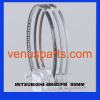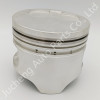High Compression ISO9001 Mitsubishi Parts Fro Diesel Engine , 4 Cylinder
MITSUBISHI PISTON 4D56 MD117177,,MD103318
A piston is a component of reciprocating engines, reciprocating pumps, gas compressors and pneumatic cylinders, among other similar mechanisms. It is the moving component that is contained by a cylinder and is made gas-tight by piston rings. In an engine, its purpose is to transfer force from expanding gas in the cylinder to the crankshaft via a piston rod and/or connecting rod. In a pump, the function is reversed and force is transferred from the crankshaft to the piston for the purpose of compressing or ejecting the fluid in the cylinder. In some engines, the piston also acts as a valve by covering and uncovering ports in the cylinder wall.
Piston Technology
Graphite Sprayed at Piston Skirt/Graphite Printing
Graphite is characterized as good lubricating, which helps lubricant adhering to coating surface. The coating will reduce friction and scratching. The thickness is between 0.01 and 0.02 mm.

Tin Coating
Tin is coated by electro analysis or heat dipping at thickness between 0.001 and 0.003mm. Tin is characterized as soft and oil-friendly which improves running-in efficiency of piston and liner. This coating is most commonly used.

Piston roof anodizing
The piston roof is anodized by electro bath, forming thin layer of Al2O3 , This treatment will improve heat resistance (above 500), heat conductivity and anti-corrosion, it helps prevent piston roof burn-up. The thickness is normally 0.02 to 0.05mm. If the thickness increases by 0.01mm, the heat conductivity will decrease by 25%, the roof temperature when running will be lower from 30 to 50. Anodizing technology and processing is normally complicated.

Piston roof MoS2 Spraying
The function is close to roof anodizing improving heat resistance. The MoS2 is also good at lubrication. (The bigger piston below is piston roof anodizing, the smaller one is MoS2 Spraying)

Phosphate
The phosphate is aimed to improve initial running-in performance. The phosphate layer is easy to wear off and helpful to improve running-in.

Ceramic Spraying
The treatment performance is similar to anodizing and heat insulation performance is better. The ideal thickness is 0.2 to 0.3mm. When running under high temperature, the ceramic is easy to crack and wear off. It is not commonly used due to high cost

Piston Type
Steel-insert piston
Steel-insert piston allows more uniform thermal expansion and tight fitting clearance.

ALFIN piston
ALFIN is inserted within the ring grooves when casting. ALFIN is made of special austenitic cast iron. It is tightly bonded metallically to piston body and counteracts the wear in the top ring groove. ALFIN pistons are commonly used in diesel engines.

Cooling channel piston
Cooling channel pistons effectively reduce piston body working and groove land temperature under high temperature working condition.

One piece casting piston
Compared to common five-pieces casting, one piece casting technology is better in efficiency and appearance, it also reduces casting flaws.
Compares piston
The sealing and guiding functions of the piston are separated from one another. The upper part is made of cast iron and the lower part is made of aluminum. The two parts is joined by bolts. The piston can perform with not only maximum strength and heat resistance, but also low wear values and optimum conditions for meeting future emission standards.
Forged piston
The forged piston allows smaller cross sections and lower piston weight. This kind of piston is installed primarily in sports car engines and heavy-duty fast-running engines.
Piston Structure

|
UAP NO. |
OEM NO. |
ENGINE MODEL |
Related Products
Didn't find what you're looking for?
Post Buying Lead or
contact our customer service specialist for help!
|




















